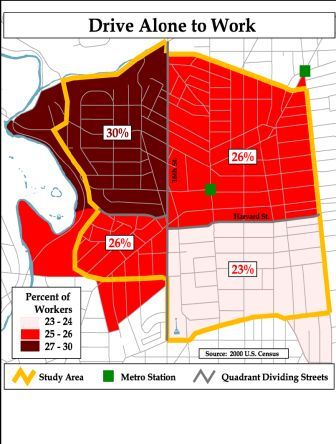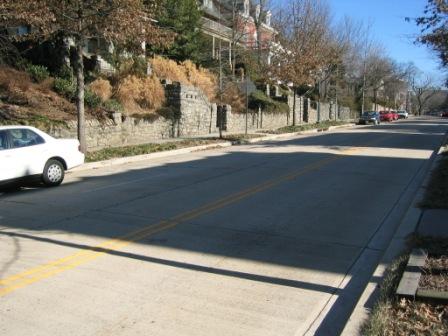This part of Washington was built before automobiles became a part of the American lifestyle, and many houses and apartments have no off-street parking. Curbside parking just doesn't meet the need, obviously. A typical row house here is on a lot about 20 feet wide, i.e., one parking spot. Many of our row houses have basement apartments, or upstairs rental units, and zoning permits some row houses to be subdivided into multiple condominiums. Throw in the apartment houses, and plainly there's just not enough parking space to go around.
A good many residents of the inner city have no car, depending instead on buses, the subway system, taxis, and the Zipcar/Flexcar short-term car rental operations. As the table in the next column shows, close to half the households in this area get along without owning a car.
* Owner-occupied units: 1409; no car: 182 (13%)
* Renter-occupied units: 3794; no car: 2055 (54%)
Columbia Heights:
* Owner-occupied units: 1648; no car: 426 (26%)
* Renter-occupied units: 7304; no car: 4825 (66%)
Adams Morgan:
* Owner-occupied units: 2956; no car: 647 (22%)
* Renter-occupied units: 6442; no car: 3178 (49%)
Total:
* Owner-occupied units: 6013; no car: 1255 (21%)
* Renter-occupied units: 17540; no car: 10058 (57%)
* Total households: 23552; no car: 11313 (48%)
Gentrification is increasing the number of homeowners, as rental dwellings are converted to owner-occupied dwellings, including the conversion of rental apartments to condominiums. These homeowners, commonly coming here from the suburbs, or from less densely populated parts of the city, bring with them their automobile-centered lifestyle. (I am one of those.) Unfortunately, our curbside parking is already packed, and anyone coming home after about 8 pm has a rough time finding a legal parking spot. That's a problem that is only going to get worse, as the number of car-owning households increases.
It's also clear that the parking problem in this area comes at night, not during the day. A considerable number of residents commute to their jobs in their personal automobiles. There are no large employers in this area, so relatively few people come here in their cars for the day. This is really poorly understood, yet is central to dealing with our parking problem. Our problem is not due to outsiders coming in and taking up parking space. It's due to us, the people living here, cramming our cars into the neighborhood at the end of the working day.
Many people complain about the number of cars with non-DC tags on our streets. Indeed, roughly one-third of the cars parked on our streets have non-DC tags. Nonetheless, after about 8 pm, most of these cars belong to people of the neighborhood, not to outsiders. What Virginia or Maryland resident is going to leave his car here, and take the bus or the Metro out to the suburbs? No doubt those cars should have DC tags, and compelling them to register their cars in the District would be appropriate, but won't make the cars leave the neighborhood, and so that won't alleviate our overnight-parking problem.

Mount Pleasant has the highest proportion in this area of residents who "drive alone to work". If there are 6,000 residents who work outside the neighborhood, then this amounts to 2,000 cars that disappear from the neighborhood in the morning (and that doesn't count car-poolers). That's why there's plenty of parking available during the day, whereas parking gets tight at night, when all those folks come home.
Nonetheless, residents convinced that RPP will somehow help them find parking at night have managed to impose RPP through much of the neighborhood. This is a hardship on the modest number of people who come to Mount Pleasant to work during the day, including the teachers and staff at Bancroft Elementary, the Elsie Stokes charter school on 16th Street, and the Sacred Heart school. Since there's ample parking for all during the day, why not let them, and the employees of Mount Pleasant Street businesses, use it?
I have proposed that such commuters serving Mount Pleasant businesses and institutions be allowed to purchase daytime-only parking permits, in numbers limited to make sure that there's ample parking during the day for residents. These permits would be limited to the day, so that those cars would depart in the evening, making space for our residents coming home from their jobs.
 Blocks near Mount Pleasant
Street should remain RPP, if only to make parking available for patrons of
the businesses. Blocks like this, too distant to be convenient, can be
permitted for commuters to Mount Pleasant institutions and businesses.
They shouldn't mind walking a few blocks to their places of
employment.
Blocks near Mount Pleasant
Street should remain RPP, if only to make parking available for patrons of
the businesses. Blocks like this, too distant to be convenient, can be
permitted for commuters to Mount Pleasant institutions and businesses.
They shouldn't mind walking a few blocks to their places of
employment. This photograph shows 1800 block of Park Road, midday on a Monday. There's plenty of parking available!
More recently, the District Department of Transportation pushed legislation that would have implemented escalating RPP permit fees -- $25 for the first permit of a household, $50 for the second, $100 for the third, and a limit of three per household. The idea was that this would discourage automobile ownership. But in fact, such modest fees would not accomplish that, and would be burdensome on extended families in single households that may need several cars. I testified against those fees, and this proposal was in fact deleted from the legislation. I also testified in favor of a restoration of some parking duration limit on residential streets (this used to be 72 hours, but is long gone), and in favor of decreasing the minimum parking distance from an intersection from 40 feet to 25 feet (incorporated in proposed legislation by Councilmember Carol Schwarz).
Schwarz Committee testimony, January 2006
return to home